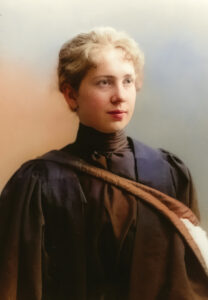Pionniers et pionnières en matière de radioactivité au Canada – Partie 1 : Harriet Brooks

Most of us working in the fields of radiological protection or radon know that we owe much of our knowledge to the work of pioneering research scientists, many of whom literally gave their lives to advance our understanding of the mysterious nature of radioactive particles. Indeed, many of these scientists are household names—Marie and Pierre Curie, Henri Becquerel, Wilhelm Rontgen, and many others.
What many of us may not realize is just how much we owe to researchers working right here in Canada. From the late 1800s to today, Canada has been at the forefront of radiological research and nuclear science. In this series of articles, we will explore some of the researchers and developments that set the stage for the fields of work we know today. What better place to start than with Harriet Brooks, Canada’s first female nuclear physicist.
Harriet was born in Exeter, ON, in 1876. She studied at McGill University in Montreal, receiving the first master’s degree in physics awarded to a woman by the institution. While at McGill, she joined Ernest Rutherford’s experimental physics research lab, where she studied the “emanations” of radioactive substances such as thorium.[1] At the time, it wasn’t known if these emanations were a gas, a vapour, or fine particles. Harriet’s work proved that the emanations were, in fact, gaseous, yet not a gaseous form of the element they’d come from. In the case of thorium, the gas was radon; Harriet was the first person to characterize it, estimating its molecular weight and measuring its decay.[1]
Further experiments showed that radon, in turn, transformed on its own into yet another element. This phenomenon was initially called “transmutation of the elements,” but is now known as radioactive decay.[2] Harriet discovered that there are sequential releases of radiation when uranium or thorium decay. Ernest Rutherford based his 1904 Bakerian lecture on this finding and gave due credit to Harriet for her contributions.[1]
Harriet was known for being very thorough, which made her perfectly suited for research in nuclear physics.[3] Her careful observations led to the discovery of the atomic recoil phenomenon in 1904. However, this concept would not be fully understood until several years after Harriet’s initial discovery, at which point it was used by researchers to separate daughter elements during radioactive decay sequences.[1]
The discoveries made during Harriet’s time are fundamental to the entire field of nuclear science that we know today. The research that Harriet was a part of earned Ernest Rutherford a Nobel Prize in Chemistry “for his investigations into the disintegration of the elements and the chemistry of radioactive substances” in 1908.[4]
Throughout the course of her academic career, Harriet won many awards, including multiple fellowships. Her abilities took her to the United States and Europe, including some time conducting research with the famous Marie Curie at the Institut du Radium in Paris.
Despite her obvious intellect and abilities, and the respect and collaboration of her colleagues, Harriet had to battle against the prevailing gender roles of the time. When she became engaged while teaching at Barnard College, her dean made it clear she was expected to resign once she was married. Harriet wrote a stirring reply, stating “it is a duty I owe to my profession and to my sex to show that a woman has the right to the practice of her profession and cannot be condemned to abandon it merely because she marries.”[3]
While Harriet called off that engagement (and also left the college) at the age of 31, she did ultimately choose marriage and domestic life over her research career. She died at the age of 56, likely as a result of radiation exposure. In an obituary written by Ernest Rutherford, he stated that “next to Mme Curie, she was the most pre-eminent woman physicist in the department of radioactivity.”[5]
Harriet’s contributions were honoured during her lifetime by her peers, who credited her contributions to their work, offered her fellowships, and sought her out as a research partner. Posthumously, she has been inducted into the Canadian Science and Engineering Hall of Fame, as well as honoured by Women in Nuclear (WiN Canada), who have named an award after her.[6] Today, we honour her as a pioneer, not only of nuclear physics, but of women in science as well.
References:
[1] Rayner-Canham, M., & Rayner-Canham, G. (2016). Brooks, Harriet. Dictionary of Canadian Biography. https://www.biographi.ca/en/bio/brooks_harriet_16E.html
[2] Canada Science and Technology Museum. (2014). Harriet Brooks Pitcher 1876-1933. http://www.sciencetech.technomuses.ca/ENGLISH/about/hallfame/u_i31_e.cfm; archived at Wayback Machine. https://web.archive.org/web/20140804095717/http:/www.sciencetech.technomuses.ca/ENGLISH/about/hallfame/u_i31_e.cfm
[3] Chang-Yen Phillips, C. (2017, March 13). Canada wasn’t ready for unsung physicist Harriet Brooks — and it’s our loss. Canada 2017. https://www.cbc.ca/2017/canada-wasn-t-ready-for-unsung-physicist-harriet-brooks-and-it-s-our-loss-1.4014177
[4]The Nobel Prize. (n.d.). Nobel Prize in Chemistry 1908. https://www.nobelprize.org/prizes/chemistry/1908/summary/
[5] Tufford, A. (2020, March 3). Harriet Brooks. The Encyclopedia of Canada. https://www.thecanadianencyclopedia.ca/en/article/harriet-brooks#:~:text=Harriet%20Brooks%20made%20important%20contributions,first%20Canadian%20female%20nuclear%20physicist
[6] Women in Nuclear. (n.d.). Harriet Brooks Award. https://womeninnuclear.com/programs-services/harriet-brooks-award/
Résumé
Voici le premier d’une série d’articles qui exploreront certains des chercheurs et des développements qui ouvrent la voie au domaine de la radioprotection que nous connaissons aujourd’hui. Quoi de mieux pour commencer que Harriet Brooks, la première physicienne nucléaire! Les recherches auxquelles elle a participé ont valu à Ernest Rutherford un prix Nobel de chimie et il a dit que Harriet était, avec Mme Currie, la plus grande physicienne et spécialiste de la radioactivité.
 Erin Curry
Erin Curry
Erin est ingénieure mécanique et dirigeait auparavant sa propre entreprise d’inspection de bâtiments et de mesure du radon. Elle est présentement directrice régionale de l’Association canadienne des scientifiques et des technologues en radon (ACSTR) et chef de projet du programme « Occupe-toi du radon ». Pour soutenir les membres de l’ACSTR, Erin apporte une richesse de connaissances et d’expériences pratiques. Localisée près de Montréal, au Québec, Erin est la ressource francophone pour toutes les initiatives de l’ACSTR.
 Anne-Marie Nicol
Anne-Marie Nicol
Anne-Marie est professeure adjointe à la faculté des Sciences de la santé de l’Université Simon Fraser, responsable de l’évaluation des risques et de l’application des connaissances et chercheuse en santé environnementale au BC Centre for Disease Control. Ses travaux sont multidisciplinaires et touchent les domaines de l’épidémiologie, de la toxicologie, du marketing social, de la perception des risques et de l’évaluation des risques. Ses domaines d’intérêt particuliers sont l’exposition environnementale et professionnelle ayant une incidence sur la santé.
Vous voulez lire d’autres articles comme celui-ci ?
Le Bulletin de l’Association canadienne de la radioprotection (ACRP) est une publication essentielle à tout professionnel de la radioprotection du Canada. Son contenu éditorial procure aux professionnels de la radioprotection les enseignements, l’information, les conseils et les solutions utiles, tous nécessaires pour demeurer à l’avant-garde de la profession.
Abonnez-vous aujourd’hui pour que nous vous envoyions un courriel chaque fois qu’un nouveau numéro est mis en ligne. Revisitez souvent le site entre chaque numéro pour obtenir les mises à jour et consulter de nouveaux articles.
Ne ratez aucun numéro. Abonnez-vous dès aujourd’hui !
Abonnez-vous

 Erin Curry
Erin Curry Anne-Marie Nicol
Anne-Marie Nicol

